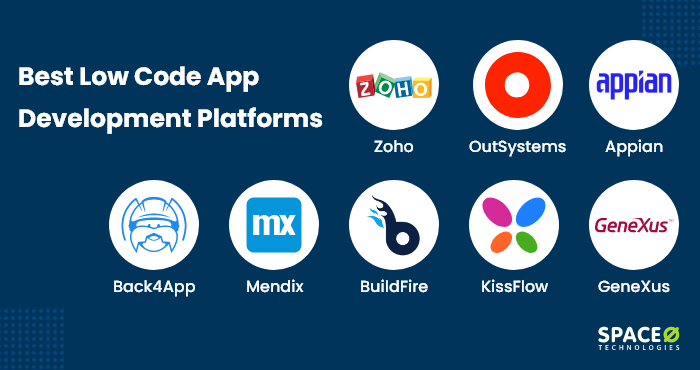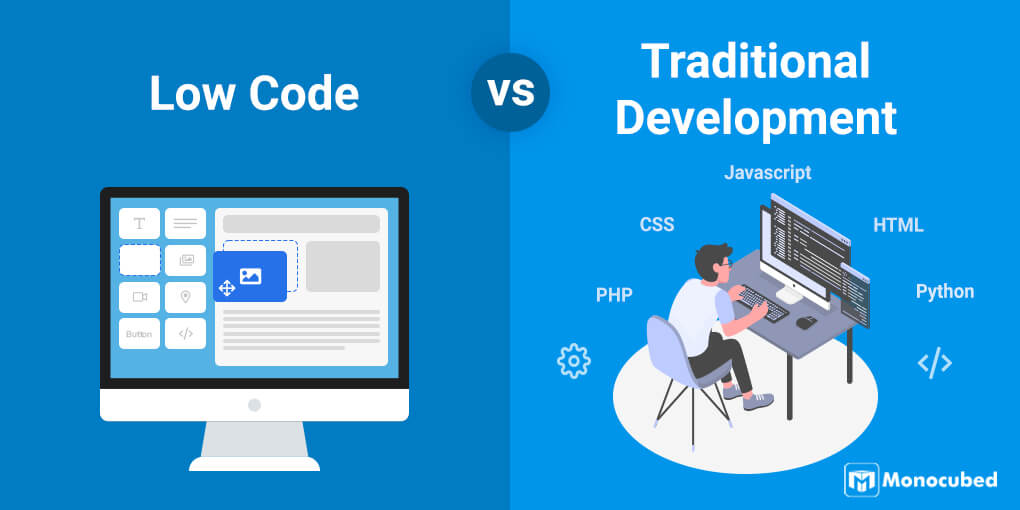Best Tips On Selecting Low-Code Platform Examples
Best Tips On Selecting Low-Code Platform Examples
Blog Article
Benefits Of Low-Code Application Development In The Sense Of Accessibility To Non-Developers
Because of a variety of factors, Low-code Application Development is accessible to people who are not developers. These are referred to as "citizen designers."
Drag-and Drop Builders: Low code platforms have drag-and drop interfaces that let non-developers develop applications without needing to write code. This makes development easier for people with technical backgrounds.
WYSIWYG Editors - "What You saw is what You Get" editors help users create workflows and interfaces that appear like the final products, making them simpler to comprehend.
Simple logic and Workflow Design
Visual Workflow Modeling: Users can design business processes and application logic using visual flowcharts and models, which are easier to understand than conventional coding techniques.
Pre-built Logic Components: Low-code platforms typically contain pre-built logic components (e.g. statements that are conditional loops) that can be easily modified, eliminating the requirement for complicated coding.
Reusable Templates and Components
Library of Pre-built Templats Many Low-Code platforms have a collection of templates based on the most common types of applications. Non-developers will be in a position to modify these templates, if required.
Reusable widgets and Modules : By using modular or reusable widgets users can streamline the process of creating them by eliminating the need for extensive technical expertise.
Guided Development and Tutorials
Step-by-Step instructions: Platforms offer instructions and help on screen for non-developers building applications.
Interactive Tutorials Interactive tutorials that are hands-on and interactive help users learn by doing, enhancing their comprehension and confidence using the platform.
Integration with existing tools
Seamless Integration - Low-code systems are easily integrated into existing systems and business tools (e.g. ERP CRM) that give even non-developers to build apps that are compatible to their workflows.
APIs Connectors: APIs are integrated into apps to facilitate integration. This allows non-developers, with no programming skills, to connect to external services.
Collaboration Features:
Team Collaboration: real-time collaboration, shared workspaces, and shared workspaces permit business analysts, non-developers and other stakeholders to effectively collaborate with developers who are professionals.
Access control based on Role: Non developers can be assigned specific roles with the appropriate access levels. This enables them to contribute to development without compromising security and performance.
Automated Testing and Debugging
Low-code platforms include tools for testing and debugging that are built in. They automate this procedure, making it much easier for nondevelopers to make sure their apps run.
Error Highlighting - When problems arise, the platform highlights the issue and offers solutions, while guiding users through the process of troubleshooting.
In general, low-code app development can make development more accessible to everyone. This is an important benefit for developers who are not. By providing intuitive, visual tools as well as guided experiences, low-code platforms enable business users to actively participate in creating and maintaining apps, thus bridging the gap between business requirements and technical implementation. Follow the top Low-code Platform for application development recommendations for site recommendations including app dev platform, app dev platform, develop web application, app modernization, application modernisation, azure sql server, rapid action development, cross platform mobile development, develop mobile application, rad development and more.
Low-Code App Development Has Numerous Benefits, Particularly In Terms Of Cost-Effectiveness.
The low-code approach to application development is a cost-effective option that offers many advantages. It's a great option for companies who want to make the most of their budgets while delivering quality apps. Here are the top advantages: Lower development costs:
Low-Code Platforms: Low-code platforms minimize the amount of hand-coding that is required which helps developers save time and energy when building applications. This translates into less labor costs.
We require fewer developer resources. Low-code development takes less time and is easier. This means that there are fewer developers needed. This will drastically lower costs of staffing and hiring.
Faster Time to Market
Accelerated Development Cycle: Visual development tools and pre-built components provided by low-code platforms allow for rapid application development, allowing companies to get their products on market quicker. This will result in faster revenues and better standing in the market.
Rapid prototyping. By quickly creating and testing prototypes, businesses can reduce time spent on developing and develop faster upon user feedback.
Low Maintenance Costs
Simpler maintenance: Low-code platforms, with their modular design and components that are standardised, are easier to maintain. This helps reduce the cost of ongoing maintenance.
Automated Updates. Many low-code platform handle updates and patch automatically. Applications remain safe without requiring a lot of manual input.
Efficient Resource Utilization:
Contributions by non-developers Low-code platforms permit non-developers as well as business users to be involved in the development process. This democratization enables enterprises to profit from the talents of a diverse spectrum of employees.
Optimized use of IT resources: IT departments have the ability to focus on more strategic initiatives, instead of getting bogged down with routine development tasks. Overall productivity and efficiency are improved.
Scalable Pricing Models:
Subscription Pricing: A lot of platforms that use low-code provide flexible pricing models based on subscriptions that are scaled according to usage. This allows companies to be able to align their spending to their actual needs and expansion, while avoiding huge initial costs.
Pay-Asyou-Go Options Certain platforms permit companies to pay for only what they use. This is especially beneficial for small or start-up businesses with a limited budget.
Reduction of Third-Party Costs for Software:
Built-in Functionalities : A low-code platform usually comes with built-in functionality and integrations that reduce the requirement for third-party software, tools and licenses.
Pre-Built Integrations: The accessibility and pre-built integrations for popular services and system minimizes the need for custom development and saves time and money.
ROI Boosted
Increased Return on Investment Accelerating development and lower costs and a faster speed to market, businesses will see a greater ROI on their investments (ROI).
Increased agility: Businesses are able to adjust quickly to changes in the market or customer demands, which allows businesses to remain relevant and take advantage of new opportunities.
Train for Less:
User-friendly interfaces: Low-code platforms have intuitive and user friendly interfaces that cut down on the learning curve. They also minimize the requirement for long-running courses of instruction.
Accessible resources: Many low-code platforms have comprehensive tutorials, training materials, as well as community support, reducing the requirement for formal training.
Streamlined Collaboration:
Enhance Collaboration Tool The built-in collaboration tool helps improve communication and cooperation among team members. This results in more efficient development processes, and reduces project overhead.
Unified Development Environment (UDE): A single, unified development environment that streamlines workflows and reduces cost and complexity that comes with managing different tools and platforms.
Overall, the efficiency of software development using low-code is due to its capability to reduce maintenance and development costs and increase time to market as well as optimize the use of resources and provide flexible price models. Low-code can provide significant financial benefits for companies. Read the most popular Enterprise application development with Low-code Platform info for site tips including application development platforms, cross platform mobile development, no code platforms, multiplatform mobile app development, rad development, jdbc server, rad application development, application modernization software, application modernisation, app platforms and more.
Advantages Of Low-Code Application Development In Terms Of Vendor Support And Community
Low-code development platforms for applications can be a fantastic option to obtain vendor support as well as community involvement. Both of these factors are vital for ensuring the success of your implementation as well as ongoing maintenance of the app. Here are some key benefits.
Comprehensive Technical Support:
A Support Team Dedicated: Most low-code platforms have a dedicated support staff that can assist with technical questions, troubleshooting issues and providing guidance. They can make sure that issues are resolved promptly.
Certain vendors provide 24/7 support. This is especially beneficial for multinational companies that have different time zones.
Training and Onboarding
Structured Training Programs: Many vendors provide structured training programs, including tutorials, webinars and courses for certification, to assist users in getting up to speed with the platform quickly.
Personalized onboarding: A lot of vendors offer tailored services for new customers to assist them in implementing the platform in a proper manner and customize it to meet their requirements.
Updates and regular updates:
Continuous Improvement Lowcode platform providers typically regularly release updates that contain new features, performance improvements, and security patches. This ensures that the platform stays current and secure.
Feedback Integration: Many companies incorporate feedback from users into their development cycles. This ensures that the platform is able to adapt to the ever-changing demands and needs of their users.
Comprehensive Documentation:
Documentation: Detailed documentation is available for most products. It covers everything from the basics to advanced customization. This can help users find solutions on their own.
API References In-depth API documentation lets developers customize applications and integrate low-code platforms into other systems.
Professional and Consulting Services
Expert Consultation: Vendors frequently provide consulting services that assist with strategic planning architectural design, as well as complex implementations, ensuring that users are able to use the platform to its maximum potential.
Custom Development Services: Some vendors will offer customized development to develop functions or integrates for their customers that aren't readily available.
Community Support
Active User Groups:
Forums and Discussion Boards: Numerous low-code platforms have lively online communities in which users can discuss issues, ask questions, and share solutions, and share the best practices.
Local and virtual user groups, as well as Meetups, provide opportunities for users to discuss their experiences, gain knowledge from other users, and connect with.
Knowledge Sharing and Collaboration:
Community-Contributed Resources: Users often share templates, modules, and extensions that they have developed, which can be reused or adapted by others, accelerating development and innovation.
Crowdsourced Solution Finding: The collective experience and wisdom of a community can be an excellent resource for finding solutions to complex problems.
Learning and Development
Community-Led Learning: Many communities hold workshops, training sessions and webinars which are typically led by users with experience who are able to provide insight and advanced techniques.
Online Tutorials and Courses: Members of the community frequently publish online tutorials, classes, and tutorials on how to do things that help students learn more.
Feedback and Influence
Forums for Product Feedback Community forums offer a variety of channels for providing feedback to vendors, which can influence the design of features.
Beta Testing Programmes Participants in the Community who are active have the opportunity of participating in beta testing programs. This gives them an early glimpse of new features and also a a chance to help shape the platform’s evolution.
Recognition and Support
Community Recognition Programs: Many vendors have recognition programs that recognize the contributions made by active members of their community such as MVP (Most Valuable Professionals) programs.
Peer Support. Community members offer assistance to each other. They offer their expertise with users who are less familiar and offer guidance. This creates an atmosphere of collaboration and support.
The overall result of a solid vendor with active, engaged communities that provide an extensive environment to support of low-code applications development. Users will be able to get the help, resources and collaboration opportunities they need to successfully build and deploy, manage, and enhance their applications.